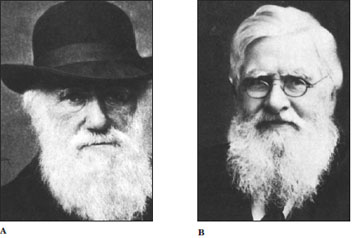Organic Evolution
A Legacy of Change
The major feature of life’s history is the legacy of perpetual change. Despite the apparent permanence of the natural world, change characterizes all things on earth and in the universe. Countless kinds of animals and plants have flourished and disappeared, leaving behind a sparse fossil record of their existence. Many, but not all, have left living descendants that bear some resemblance to them.
Life’s changes are observed and measured in many ways. On a short evolutionary timescale, we see changes in the frequencies of different genetic traits within populations. Evolutionary changes in the relative frequencies of light- and dark-colored moths were observed within a single human lifetime in the polluted countryside of industrial England. The formation of new species and dramatic changes in the appearances of organisms, as seen in the evolutionary diversification of Hawaiian birds, requires longer timescales covering 100,000 to 1 million years. Major evolutionary trends and periodic mass extinctions occur on even larger timescales, covering tens of millions of years. The fossil record of horses through the past 50 million years shows a series of different species replacing older ones through time and ending with the horses that we know today. The fossil record of marine invertebrates shows us a series of mass extinctions separated by intervals of approximately 26 million years.
The earth bears its own record of the irreversible, historical change that we call organic evolution. Because every feature of life as we know it today is a product of the evolutionary process, biologists consider organic evolution the keystone of all biological knowledge.
In Life: Biological Principles and the Science of Zoology, we introduced Darwinian evolutionary theory as the dominant paradigm of biology. Charles Robert Darwin and Alfred Russel Wallace (Figure 6-1) first established evolution as a powerful scientific theory. Today the reality of organic evolution can be denied only by abandoning reason. As the noted English biologist Sir Julian Huxley wrote, “Charles Darwin effected the greatest of all revolutions in human thought, greater than Einstein’s or Freud’s or even Newton’s, by simultaneously establishing the fact and discovering the mechanism of organic evolution.” Darwinian theory helps us to understand both the genetics of populations and long-term trends in the fossil record. Darwin and Wallace were not the first, however, to consider the basic idea of organic evolution, which has an ancient history. We review the history of evolutionary thinking as it led to Darwin’s theory and then discuss evidence supporting it.
The major feature of life’s history is the legacy of perpetual change. Despite the apparent permanence of the natural world, change characterizes all things on earth and in the universe. Countless kinds of animals and plants have flourished and disappeared, leaving behind a sparse fossil record of their existence. Many, but not all, have left living descendants that bear some resemblance to them.
 |
| Figure 6-1 Founders of the theory of natural selection. A, Charles Robert Darwin (1809 to 1882), as he appeared in 1881, the year before his death. B, Alfred Russel Wallace (1823 to 1913) in 1895. Darwin and Wallace independently developed the same theory. A letter and essay from Wallace written to Darwin in 1858 spurred Darwin into writing The Origin of Species, published in 1859. |
Life’s changes are observed and measured in many ways. On a short evolutionary timescale, we see changes in the frequencies of different genetic traits within populations. Evolutionary changes in the relative frequencies of light- and dark-colored moths were observed within a single human lifetime in the polluted countryside of industrial England. The formation of new species and dramatic changes in the appearances of organisms, as seen in the evolutionary diversification of Hawaiian birds, requires longer timescales covering 100,000 to 1 million years. Major evolutionary trends and periodic mass extinctions occur on even larger timescales, covering tens of millions of years. The fossil record of horses through the past 50 million years shows a series of different species replacing older ones through time and ending with the horses that we know today. The fossil record of marine invertebrates shows us a series of mass extinctions separated by intervals of approximately 26 million years.
The earth bears its own record of the irreversible, historical change that we call organic evolution. Because every feature of life as we know it today is a product of the evolutionary process, biologists consider organic evolution the keystone of all biological knowledge.
In Life: Biological Principles and the Science of Zoology, we introduced Darwinian evolutionary theory as the dominant paradigm of biology. Charles Robert Darwin and Alfred Russel Wallace (Figure 6-1) first established evolution as a powerful scientific theory. Today the reality of organic evolution can be denied only by abandoning reason. As the noted English biologist Sir Julian Huxley wrote, “Charles Darwin effected the greatest of all revolutions in human thought, greater than Einstein’s or Freud’s or even Newton’s, by simultaneously establishing the fact and discovering the mechanism of organic evolution.” Darwinian theory helps us to understand both the genetics of populations and long-term trends in the fossil record. Darwin and Wallace were not the first, however, to consider the basic idea of organic evolution, which has an ancient history. We review the history of evolutionary thinking as it led to Darwin’s theory and then discuss evidence supporting it.




